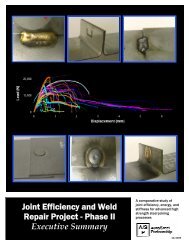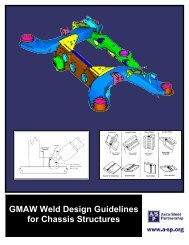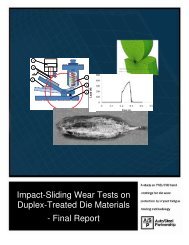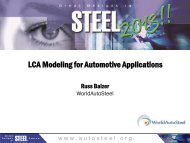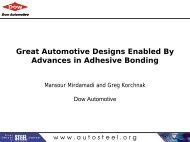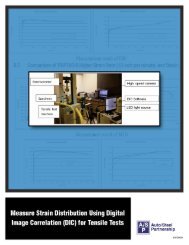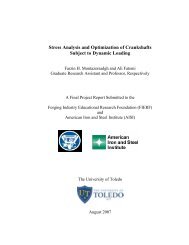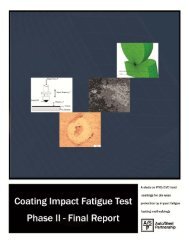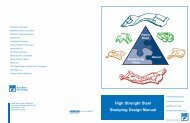Light Truck Frame Joint Stiffness Study Phase 1 Final Report
Light Truck Frame Joint Stiffness Study Phase 1 Final Report
Light Truck Frame Joint Stiffness Study Phase 1 Final Report
You also want an ePaper? Increase the reach of your titles
YUMPU automatically turns print PDFs into web optimized ePapers that Google loves.
JOINT STIFFNESS TOOLBOX<br />
Notes:<br />
* Modify the input values (yellow) based on<br />
your design criteria. The calculated stiffness<br />
will be displayed in red.<br />
* Design variables are listed in order of<br />
influence on stiffness.<br />
Illustration Key:<br />
A = Side Rail End Square<br />
B = Side Rail Plate<br />
C = Crossmember<br />
D = Side Rail C Channel<br />
Design Rules:<br />
* Increase crossmember thickness to<br />
increase stiffness in all three directions.<br />
* Increase crossmember thickness to<br />
increase stiffness in all three directions.<br />
* Increasing the side rail height<br />
increases the stiffness in the Bending<br />
(Kx) and Torsional (Ky) loading<br />
directions, but decreases the stiffness<br />
in the Fore/Aft (Kz) direction.<br />
* All of the other design variables have<br />
a small, but significant impact on the<br />
joint stiffness.<br />
* Click on the animation to the left of the<br />
variables and loading conditions to see an<br />
animation of respective shape variable or<br />
loading condition.<br />
* The mass calculation is based on 150 mm<br />
extension of joint members from the side rail<br />
to interface. This is to serve as a reference,<br />
not the absolute value.<br />
* The password to unprotect cells in this<br />
spreadsheet is: steel.<br />
<strong>Joint</strong> Observations<br />
* Fore/aft compliance is a combination of<br />
deflections in the crossmember, bottom<br />
reinforcement, and side rail after wall. The<br />
max stress occurs at the top and bottom<br />
corners of the crossmember.<br />
* Vertical compliance is a combination of side<br />
rail, crossmember and bottom plate deflection.<br />
* Torsion compliance is mostly in the<br />
crossmember and is probably higher because<br />
of the hole in the crossmember. High stress<br />
occurs in the bottom reinforcement plate at<br />
the weld temination and the top of the side<br />
rail.<br />
* Thickness Importance: Crossmember<br />
thickness then outer Side Rail and plate<br />
thickness.<br />
Figure 35: <strong>Joint</strong> 2 <strong>Joint</strong> <strong>Stiffness</strong> Toolbox Spreadsheet<br />
<strong>Joint</strong> Observations, Notes and Design Rules<br />
<strong>Report</strong>: A/SP-005-1 <strong>Light</strong> <strong>Truck</strong> <strong>Frame</strong> <strong>Joint</strong> <strong>Stiffness</strong> <strong>Study</strong> 62



